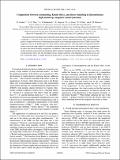| dc.contributor.author | Ciudad, David | |
| dc.contributor.author | Arena, D. A. | |
| dc.contributor.author | Han, X.-F. | |
| dc.contributor.author | Hindmarch, A. T. | |
| dc.contributor.author | Marrows, C. H. | |
| dc.contributor.author | Negusse, E. | |
| dc.contributor.author | Wen, Z.-C. | |
| dc.date.accessioned | 2012-08-30T16:13:30Z | |
| dc.date.available | 2012-08-30T16:13:30Z | |
| dc.date.issued | 2012-06 | |
| dc.date.submitted | 2012-05 | |
| dc.identifier.issn | 1098-0121 | |
| dc.identifier.issn | 1550-235X | |
| dc.identifier.uri | http://hdl.handle.net/1721.1/72473 | |
| dc.description.abstract | The transition between Kondo and Coulomb blockade effects in discontinuous double magnetic tunnel junctions is explored as a function of the size of the CoPt magnetic clusters embedded between AlO[subscript x] tunnel barriers. A gradual competition between cotunneling enhancement of the tunneling magnetoresistance (TMR) and the TMR suppression due to the Kondo effect has been found in these junctions, with both effects having been found to coexist even in the same sample. It is possible to tune between these two states with temperature (at a temperature far below the cluster blocking temperature). In addition, when further decreasing the size of the CoPt clusters, another gradual transition between the Kondo effect and direct tunneling between the electrodes takes place. This second transition shows that the spin-flip processes found in junctions with impurities in the barrier are in fact due to the Kondo effect. A simple theoretical model able to account for these experimental results is proposed. | en_US |
| dc.description.sponsorship | United States. Dept. of Energy. Office of Basic Energy Sciences (contract no. DE-AC02-98CH10886) | en_US |
| dc.description.sponsorship | Spanish Ministry of Science and Innovation (postdoctoral grant no. 2008-0352) | en_US |
| dc.description.sponsorship | Seventh Framework Programme (European Commission) (Marie Curie International Outgoing Fellowship) | en_US |
| dc.language.iso | en_US | |
| dc.publisher | American Physical Society | en_US |
| dc.relation.isversionof | http://dx.doi.org/10.1103/PhysRevB.85.214408 | en_US |
| dc.rights | Article is made available in accordance with the publisher's policy and may be subject to US copyright law. Please refer to the publisher's site for terms of use. | en_US |
| dc.source | APS | en_US |
| dc.title | Competition between cotunneling, Kondo effect, and direct tunneling in discontinuous high-anisotropy magnetic tunnel junctions | en_US |
| dc.type | Article | en_US |
| dc.identifier.citation | Ciudad, D. et al. “Competition Between Cotunneling, Kondo Effect, and Direct Tunneling in Discontinuous High-anisotropy Magnetic Tunnel Junctions.” Physical Review B 85.21 (2012): 214408. © 2012 American Physical Society. | en_US |
| dc.contributor.department | Francis Bitter Magnet Laboratory (Massachusetts Institute of Technology) | en_US |
| dc.contributor.approver | Ciudad, David | |
| dc.contributor.mitauthor | Ciudad, David | |
| dc.relation.journal | Physical Review B | en_US |
| dc.eprint.version | Final published version | en_US |
| dc.type.uri | http://purl.org/eprint/type/JournalArticle | en_US |
| eprint.status | http://purl.org/eprint/status/PeerReviewed | en_US |
| dspace.orderedauthors | Ciudad, D.; Wen, Z.-C.; Hindmarch, A.; Negusse, E.; Arena, D.; Han, X.-F.; Marrows, C. | en |
| mit.license | PUBLISHER_POLICY | en_US |
| mit.metadata.status | Complete | |
